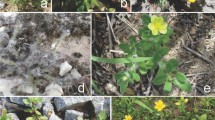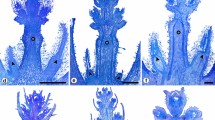Abstract
The inflorescences ofPaspalum are composed of a main axis and 1 to more than 100 raceme-like lateral branches arranged along it. Each branch bears two rows of homogeneous subunits composed either of one or two consecutive-ordered axes, each one ending with a spikelet. In terms ofTroll's descriptive and typological system, such lateral branches were regarded as long paracladia which bear homogeneous bi-axial short paracladia. The structural pattern of these long paracladia is considered to be a recapitulation of the distal main-axis structure which was lost by evolutionary truncation. — The occurrence of a main florescence (= terminal spikelet) and a short paracladia-bearing zone at the distal portion of the main axis in several species of the genusPaspalum, as it is exemplified by species belonging to the so-called ‘Quadrifaria group’, seems to support the hypothesis that the usual inflorescence ofPaspalum actually derived from a paniculate structure by evolutionary homogenization and truncation processes. This ‘Quadrifaria-type inflorescences’ would be regarded as an intermediate step in the evolutionary pathway. Nevertheless, the phylogenetic implications of this interpretation remains obscure because at the present time there is not any hypothesis about the phylogeny of the genus available.
Similar content being viewed by others
References
Barreto, L., 1954: Las especies afines aPaspalum virgatum en la América del Sur. — Revista Argent. Agron.21: 125–142.
—, 1966: Las especies afines aPaspalum quadrifarium (Gramineae) en la América del Sur de clima subtropical y templado. — Darwiniana14: 130–160.
Butzin, F., 1970: Die systematische Gliederung derPaniceae. — Willdenowia6: 179–192.
Cámara-Hernández, J., Bellón, R. R., 1992: Dorsiventrality in the inflorescence and vegetative axis ofZea diploperennis (Poaceae). — Beitr. Biol. Pflanzen67: 59–72.
—, 1991: The synflorescence ofPoaceae. — Beitr. Biol. Pflanzen66: 297–311.
Chase, A., 1929: The North American species ofPaspalum. — Contr. U.S. Natl. Herb.28: 1–310.
Clayton, W. D., Renvoize, S. A., 1986: Genera Graminum, grasses of the World. — Kew Bulletin, Add. Ser.13: 1–389.
Filgueiras, T. S., 1994: Nomenclatural and critical notes on some Brazilian species ofPaspalum (Poaceae, Paniceae). — Acta Amazon.23: 147–161.
Judziewicz, E. J., 1990:Poaceae (Gramineae). — InGörts-Van Rijn, A. R. A., (Ed.): Flora of the Guianas. — Königstein: Koeltz.
Kunze, H., 1989: Probleme der Infloreszenztypologie vonW. Troll. — Pl. Syst. Evol.163: 187–199.
Maresquelle, H. J., 1970: Le thème évolutif des complexes d'inflorescences. Son aptitude à susciter des problèmes nouveaux. — Bull. Soc. Bot. France117: 1–4.
Parodi, L. R., Nicora, E. G., 1966: Apuntes para una monografía del géneroPaspalum. — Unpublished (copy in ABO).
Pilger, R. K. F., 1941:Gramineae, Panicoideae. — InEngler, A., Prantl, K., (Eds): Die natürlichen Pflanzenfamilien,14e: 1–208. 2nd edn. — Leipzig: Engelmann.
Rua, G. H., Boccaloni, I. B., 1996: The inflorescences ofDigitaria phaeotrix: morphological and developmental aspects. — Flora191: 117–119.
Sell, Y., 1969: Les complexes inflorescentiels de quelques Acanthacées. Étude particulière des phénomènes de condensation, de racemisation, d'homogénéisation et de troncature. — Ann. Sci. Nat. Bot. Biol. vég., 12 sér.,10: 225–350.
—, 1976: Tendances évolutives parmi les complexes inflorescentiels. — Rev. Gén. Bot.83: 247–267.
—, 1980: Physiological and phylogenetic significance of the direction of flowering in inflorescence complexes. — Flora169: 282–294.
Semikhov, V. F., 1984: Study of the aminoacid and protein fraction composition of the seeds in the tribePaniceae R. Br. in relation to systematics and phylogeny. — Bjull. Moskovsk. Obšč. Isp. Prir., Otd. Biol89: 105–114.
Stebbins, G. L., 1982: Major trends of evolution in thePoaceae and their possible significance. — InEstes, J. R., Tyrl, R. J., Brunken, J. N., (Eds): Grasses and grasslands. Systematics and ecology, pp. 3–36. — Norman: University of Oklahoma Press.
Swallen, J. R., 1967: New species ofPaspalum. — Phytologia14: 358–389.
Takhtajan, A., 1991: Evolutionary trends in flowering plants. — New York: Columbia University Press.
Troll, W., 1964/69: Die Infloreszenzen, Typologie und Stellung im Aufbau des Vegetationskörpers. I, II/1. — Jena: G. Fischer.
—, 1965: Ber. Komm. f. biol. Forschung. — Jahrb. Akad. Wiss. Lit. Mainz1964: 93–109.
—, 1966: Ber. Komm. f. biol. Forschung. — Jahrb. Akad. Wiss. Lit. Mainz1965: 110–131.
—, 1969: Ber. Komm. f. biol. Forschung. — Jahrb. Akad. Wiss. Lit Mainz1968: 88–105.
—, 1974: Ber. Komm. f. biol. Forschung. — Jahrb. Akad. Wiss. Lit. Mainz1973: 135–151.
Vegetti, A., 1987: Análisis tipológico de la inflorescencia enPaspalum (Poaceae). — Kurtziana19: 155–160.
-Weberling, F., 1996: The structure of the paracladial zone inPoaceae. — Taxon (in press).
Weberling, F., 1961: Die Infloreszenzen der Valerianaceen und ihre systematische Bedeutung. — Abh. Akad. Wiss. Lit. Mainz, math.-naturw. Klasse5: 151–281.
—, 1965: Typology of inflorescences. — Bot. J. Linn. Soc.59: 215–221.
—, 1981: Morphologie der Blüten und der Blütenstände. — Stuttgart: Ulmer.
—, 1993: Zur deskriptiven und vergleichendmorphologischen Terminologie komplexer Infloreszenzen. — Beitr. Biol. Pflanzen67: 453–473.
Author information
Authors and Affiliations
Rights and permissions
About this article
Cite this article
Rua, G.H. The inflorescences ofPaspalum (Poaceae, Paniceae): TheQuadrifaria group and the evolutionary pathway towards the fully homogenized, truncated common type. Pl Syst Evol 201, 199–209 (1996). https://doi.org/10.1007/BF00989061
Received:
Accepted:
Issue Date:
DOI: https://doi.org/10.1007/BF00989061




